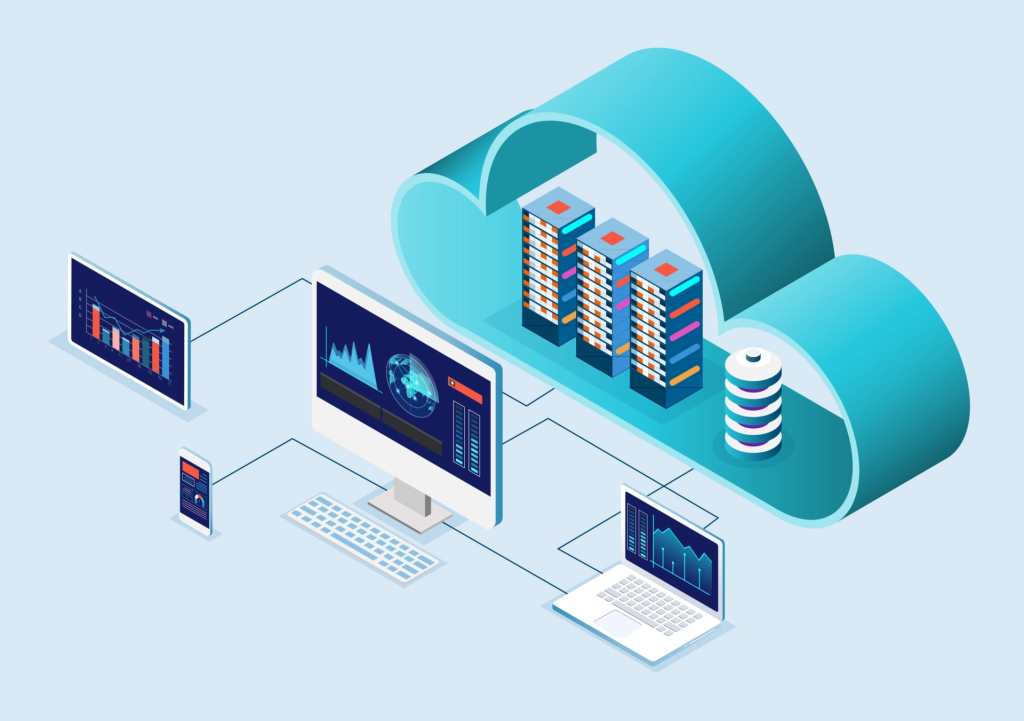As of April 2023, the cloud market has continued to grow at a rapid pace, with businesses of all sizes increasingly relying on cloud services to power their operations. Let’s take a look at the cloud ecosystem in 2023 and examine the market share of the major cloud providers.
- Amazon Web Services (AWS): Despite increasing competition, AWS remains the dominant player in the cloud market, with an estimated market share of around 32%. AWS has continued to innovate and expand its offerings, with a particular focus on artificial intelligence (AI) and machine learning (ML) services.
- Microsoft Azure: Azure is the second-largest cloud provider, with an estimated market share of around 18%. Microsoft has been investing heavily in its cloud offerings, and Azure is now a critical part of the company’s strategy. Azure has also been gaining ground in the AI and ML space, with a wide range of services for developers.
- Google Cloud Platform (GCP): GCP has been steadily gaining market share, with an estimated market share of around 10%. Google has been leveraging its expertise in AI and ML to differentiate itself from its competitors, with a wide range of advanced tools for developers.
- Alibaba Cloud: Alibaba is the dominant cloud provider in China, with an estimated market share of around 7%. Alibaba has been expanding rapidly outside of China, with a focus on serving customers in Asia.
- IBM Cloud: IBM has been focusing on the enterprise market, with a wide range of services for large businesses. IBM’s market share is estimated to be around 5%.
- Oracle Cloud: Oracle has been investing heavily in its cloud offerings, with a particular focus on cloud infrastructure and databases. Oracle’s market share is estimated to be around 4%.
- Other Cloud Providers: There are a wide range of other cloud providers, including smaller players like DigitalOcean, Linode, and Vultr. These providers typically serve smaller businesses or specialize in specific areas, such as hosting WordPress sites or providing bare metal servers.
The cloud market is highly competitive, with new players entering the market and existing players expanding their offerings. The continued growth of the cloud market is a testament to the value that businesses are finding in cloud services, and we can expect to see continued innovation and investment in the space in the coming years.
Understanding the Three Main Types of Cloud Computing Services
Cloud computing services can be broadly categorized into three main types: Infrastructure as a Service (IaaS), Platform as a Service (PaaS), and Software as a Service (SaaS).
- Infrastructure as a Service (IaaS): IaaS is a cloud computing service model that provides virtualized computing infrastructure to customers over the internet. This includes computing resources like virtual machines, storage, networking, and operating systems. Customers can deploy and manage their own software applications on this infrastructure, without having to own or manage the underlying hardware. Examples of IaaS providers include Amazon Web Services (AWS), Microsoft Azure, and Google Cloud Platform.
- Platform as a Service (PaaS): PaaS is a cloud computing service model that provides a complete platform for customers to develop, deploy, and manage their software applications. This includes computing infrastructure, operating systems, programming languages, and tools for building and testing applications. PaaS providers typically abstract away the underlying infrastructure, allowing customers to focus on application development and deployment. Examples of PaaS providers include Heroku, Google App Engine, and IBM Bluemix.
- Software as a Service (SaaS): SaaS is a cloud computing service model that provides software applications over the internet. Customers can access these applications through a web browser or mobile app, without having to install or manage any software on their own devices. SaaS providers typically host and maintain the software applications, and customers pay a subscription fee to use them. Examples of SaaS providers include Salesforce, Dropbox, and Microsoft Office 365.
Each of these cloud computing service models offers unique benefits and trade-offs, and businesses can choose the model that best fits their needs. IaaS provides the most control and flexibility, but requires more technical expertise to manage. PaaS abstracts away some of the underlying infrastructure, but limits the flexibility of the environment. SaaS provides the easiest and most convenient access to software applications, but may not provide the customization options that some businesses require.

An Overview of the Cloud Computing Market in 2023
As of 2023, the cloud computing market continues to grow rapidly, driven by increasing demand for cloud services from businesses of all sizes. Here is an overview of the cloud computing market in 2023:
- Market Size: The global cloud computing market is expected to reach $623.3 billion by 2023, growing at a compound annual growth rate (CAGR) of 18.7%. The market size is driven by increasing adoption of cloud services across industries and geographies.
- Deployment Models: Cloud computing services are typically offered through three deployment models: public cloud, private cloud, and hybrid cloud. Public cloud remains the most popular deployment model, followed by private cloud and hybrid cloud.
- Service Models: Cloud computing services are also offered through three service models: Infrastructure as a Service (IaaS), Platform as a Service (PaaS), and Software as a Service (SaaS). SaaS is the largest service model by revenue, followed by IaaS and PaaS.
- Cloud Providers: The cloud computing market is dominated by a few major players, including Amazon Web Services (AWS), Microsoft Azure, and Google Cloud Platform (GCP). These providers offer a wide range of cloud services, including IaaS, PaaS, and SaaS.
- Emerging Technologies: The cloud computing market is also being driven by emerging technologies such as artificial intelligence (AI), machine learning (ML), and the Internet of Things (IoT). These technologies are being integrated into cloud services to provide new capabilities and drive innovation.
- Industry Adoption: Cloud computing adoption continues to increase across industries, including healthcare, finance, retail, and manufacturing. Many businesses are adopting cloud services to reduce costs, improve efficiency, and gain access to new capabilities.
The cloud computing market is expected to continue to grow rapidly in the coming years, driven by increasing demand for cloud services and emerging technologies. Businesses of all sizes are adopting cloud services to improve their operations and gain a competitive advantage in the marketplace
A Deep Dive into the SaaS Public Cloud Market Share
Software as a Service (SaaS) is a cloud computing service model that provides software applications over the internet. The SaaS market is dominated by a few major players, and here is a deep dive into the SaaS public cloud market share:
- Market Size: The global SaaS market size is expected to reach $307.3 billion by 2026, growing at a CAGR of 18.3%. The SaaS public cloud market represents a significant portion of this market, with a projected size of $157.4 billion by 2024.
- Market Share by Provider: The SaaS public cloud market is dominated by a few major players. According to Synergy Research Group, as of Q2 2021, the top five SaaS public cloud providers by revenue share were: Microsoft (17%), Salesforce (12%), Adobe (9%), Oracle (8%), and SAP (6%). Other notable players in the market include Google Cloud Platform, IBM, and Dropbox.
- Market Share by Application: Within the SaaS public cloud market, certain applications are more popular than others. According to Gartner, as of 2021, the top five SaaS application segments by market share were: customer relationship management (CRM), enterprise resource planning (ERP), human capital management (HCM), content services, and supply chain management.
- Market Share by Industry: SaaS public cloud adoption varies by industry, with some industries being more likely to adopt cloud services than others. According to Gartner, as of 2021, the top industries for SaaS adoption were: professional services, banking and securities, communications, manufacturing, and retail.
- Market Share by Geography: SaaS public cloud adoption also varies by geography, with some regions being more likely to adopt cloud services than others. According to Synergy Research Group, as of Q2 2021, North America accounted for 60% of the SaaS public cloud market, followed by EMEA (Europe, Middle East, and Africa) at 24% and APAC (Asia-Pacific) at 16%.
The SaaS public cloud market is dominated by a few major players, with Microsoft and Salesforce leading the pack. Adoption of SaaS public cloud services varies by application, industry, and geography, with CRM, professional services, and North America being among the top segments. The market is expected to continue to grow rapidly in the coming years, driven by increasing demand for cloud services and digital transformation initiatives across industries.

Evolution of the SaaS Market
The Software as a Service (SaaS) market has evolved significantly since its inception in the late 1990s. Here’s a look at the key milestones in the evolution of the SaaS market:
- Emergence: The SaaS market emerged in the late 1990s, driven by the need for businesses to reduce their IT costs and complexity. Salesforce.com is considered one of the pioneers of the SaaS market, with its launch of a web-based CRM system in 1999.
- Growth: The SaaS market experienced significant growth in the early 2000s, as more businesses began to adopt cloud-based software solutions. The growth of the market was also driven by the development of new technologies such as broadband internet, virtualization, and mobile devices.
- Consolidation: In the mid-2000s, the SaaS market went through a period of consolidation as larger companies began to acquire smaller SaaS vendors. Notable acquisitions during this time included Oracle’s acquisition of NetSuite in 2016 and Salesforce’s acquisition of ExactTarget in 2013.
- Maturation: The SaaS market matured in the late 2000s and early 2010s, as more businesses began to adopt cloud-based solutions as part of their IT strategies. The market also became more competitive, with a wider range of SaaS vendors offering solutions for different business needs.
- Expansion: In recent years, the SaaS market has continued to expand, with more businesses adopting cloud-based software solutions and new vendors entering the market. The market has also expanded beyond traditional enterprise applications such as CRM and ERP, to include new areas such as cybersecurity, data analytics, and artificial intelligence.
- Integration: Today, the SaaS market is characterized by a focus on integration, with businesses looking to integrate different SaaS solutions to create a seamless workflow. SaaS vendors are also partnering with each other to offer integrated solutions that meet the specific needs of businesses.
The SaaS market has evolved significantly since its emergence in the late 1990s, driven by technological advancements, changing business needs, and increasing demand for cloud-based software solutions. The market is expected to continue to grow and evolve in the coming years, with new technologies and business needs driving innovation in the market.
Exploring and Understanding the IaaS and PaaS Public Cloud Market
Infrastructure as a Service (IaaS) and Platform as a Service (PaaS) are two popular cloud computing service models that provide different levels of cloud infrastructure and application development platforms to businesses. Here’s an overview of the IaaS and PaaS public cloud market:
- Market Size: The global IaaS and PaaS public cloud market size is expected to reach $305.8 billion by 2026, growing at a CAGR of 27.6%. The IaaS market is expected to be the largest segment, with a projected size of $101.5 billion by 2024, followed by the PaaS market at $97.5 billion.
- Market Share by Provider: The IaaS and PaaS public cloud market is dominated by a few major players. According to Synergy Research Group, as of Q2 2021, the top five IaaS and PaaS public cloud providers by revenue share were: Amazon Web Services (AWS) (33%), Microsoft Azure (18%), Google Cloud Platform (9%), Alibaba Cloud (6%), and IBM (5%).
- Market Share by Application: Within the IaaS and PaaS public cloud market, certain applications are more popular than others. According to Gartner, as of 2021, the top five IaaS and PaaS application segments by market share were: application development, analytics and business intelligence (BI), cloud-native infrastructure, database management systems (DBMSs), and artificial intelligence (AI) and machine learning (ML) platforms.
- Market Share by Industry: IaaS and PaaS public cloud adoption also varies by industry, with some industries being more likely to adopt cloud services than others. According to Gartner, as of 2021, the top industries for IaaS and PaaS adoption were: banking and securities, communications, healthcare, manufacturing, and professional services.
- Market Share by Geography: IaaS and PaaS public cloud adoption varies by geography, with some regions being more likely to adopt cloud services than others. According to Synergy Research Group, as of Q2 2021, North America accounted for 54% of the IaaS and PaaS public cloud market, followed by EMEA (Europe, Middle East, and Africa) at 29% and APAC (Asia-Pacific) at 17%.
The IaaS and PaaS public cloud market is dominated by a few major players, with AWS and Microsoft Azure leading the pack. Adoption of IaaS and PaaS public cloud services varies by application, industry, and geography, with application development, banking and securities, and North America being among the top segments. The market is expected to continue to grow rapidly in the coming years, driven by increasing demand for cloud services and digital transformation initiatives across industries
Also Read : 3 Relevant ML Algorithms Commonly Used in Commercial AI Projects





